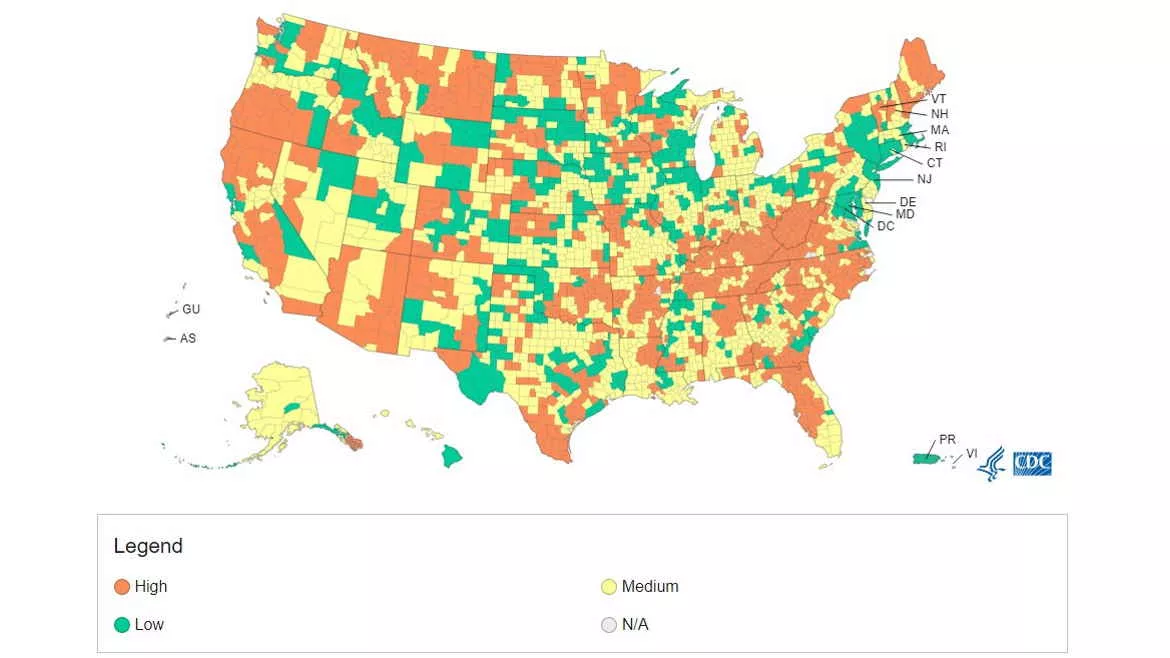CDC Guidelines Say Roofing Contractors Can Go Without Masks in Most of U.S.

The COVID-19 Community Levels as of Feb. 24, 2022 under the new monitoring framework. Image: CDC.
Roofing contractors throughout the U.S. can ease up on wearing masks with the latest guidelines put in place by the Centers for Disease Control and Prevention (CDC).
On Feb. 25, the CDC announced new guidelines for wearing masks to protect against COVID-19. Under the new guidance, around 70% of the U.S. population is currently living in an area where residents can go indoors without masks.
The new guidelines categorize areas by "low," "medium" or "high" COVID-19 community levels. Those in low areas can choose to wear a mask based on personal preference. In medium areas, the CDC recommends talking to your doctor about wearing a mask if you're at increased risk for severe illness (such as older people or those with certain medical conditions). In areas with high levels, the CDC recommends using masks indoors in public regardless of vaccination status or individual risk. People who want to wear a mask at any time can do so.
To determine your area’s current level, visit the CDC website and search by state and county.
“We want to give people a break from things like mask wearing when our levels are low and then have the ability to reach for them again, should things get worse in the future,” said Dr. Rochelle Walensky, CDC director, in a media briefing on Feb. 25.
The new guidelines reflect the current conditions of the pandemic, where there is widespread immunity through vaccination and prior infection along with improved access to testing and treatments. Additionally, new cases are on the decline in the U.S., dropping 37.7% as of Feb. 23 in the seven-day average, according to CDC data.
The changes to the guidelines reflect a shift away from tracking the number of cases to tracking the number of beds occupied by COVID-19 patients and hospitalizations caused by COVID. Areas deemed “high” are those with concerning levels of COVID-19 hospitalizations and hospital capacity taken up by COVID-19 patients.
“As the virus continues to circulate in our communities, we must focus our metrics beyond just cases in the community and direct our efforts toward protecting people at high risk for severe illness and preventing COVID-19 from overwhelming our hospitals and our healthcare systems,” said Walensky.
As with previous mask guideline changes, roofing contractors should consider the job type when determining whether wearing masks are appropriate. Working at a senior living center or hospital, for instance, may require workers to use masks to protect vulnerable residents. Customers may also request that crews wear masks.
The new guidelines do not apply to public transportation, meaning masks are required for conveyances like airplanes, subways, buses, taxis and ride-shares.
Regardless of local conditions, people are encouraged to wear a mask if they have COVID-19 symptoms, test positive for the virus or were exposed to someone with COVID-19. Medical experts caution that the virus is still a threat to people who are vulnerable to severe illness.
“We continue to recommend that people stay up to date on vaccines and get tested if they’re sick,” Walensky said.
N95 and KN95 masks have been shown to be the most effective at preventing transmission than other types of masks. However, the CDC emphasizes that people wear the mask that has the best protection and filtration for them and that they will consistently wear.
Looking for a reprint of this article?
From high-res PDFs to custom plaques, order your copy today!






